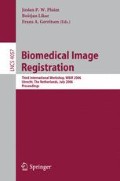Abstract
Therapeutic outcomes from radiation treatment planning (RTP) may be improved by combining tumour metabolism data with anatomic location via PET/CT image fusion. The aim of this work is to reveal the spatial accuracy, reproducibility and speed of registration techniques used in Gemini PET/CT system as a part of quality assurance. A multi-layer alignment device and a Rando Man phantom were used to validate PET/CT intrinsic alignment. Known transformations were performed to simulate different misalignment between PET and CT phantom images. Point-based and image-based registration techniques used to correct misalignment were assessed and compared quantitatively by measuring absolute distances between the centroids of corresponding fiducial markers in the registered volumes. In comparison with phantom studies using image-based registration, point-based registration shows better spatial accuracy and faster correlation, but longer time and more effort in human intervention. The experimental findings confirm that Gemini can produce robust intrinsic image alignment, as well as the accurate PET/CT image registration with careful user interaction.
Access this chapter
Tax calculation will be finalised at checkout
Purchases are for personal use only
Preview
Unable to display preview. Download preview PDF.
References
Scott, A.M.: Current status of positron emission tomography in oncology. Australasian Radiology 46, 154–162 (2002)
Klabbers, B.M., de Munck, J.C., Slotman, B.J., et al.: Matching PET and CT scans of the head and neck area: Development of method and validation. Medical Physics 29, 2230–2238 (2002)
Beyer, T., Townsend, D.W., Blodgett, T.M.: Dual-modality PET/CT tomography for clinical oncology. Quarterly Journal of Nuclear Medicine 46, 24–34 (2002)
Reinartz, P., Wieres, F., Schneider, W., et al.: Side-by-side reading of PET and CT scans in oncology: which patients might profit from integrated PET/CT? Eur. J. Nucl. Med. Mol. Imaging 31, 1456–1461 (2004)
Wahl, R.L.: Why nearly all PET of abdominal and pelvic cancers will be performed as PET/CT? JNM 45, 82S–95S (2004)
Goerres, G.W., von Schulthess, G.K., Steinert, H.C.: Why most PET of lung and head-and-neck cancer will be PET /CT? JNM 45, 66S–71S (2004)
Heron, D.E., Andrade, R.S., Flickinger, J., et al.: Hybrid PET-CT simulation for RTP in head-and-neck cancers: A brief technical report. International Journal of Radiation Oncology, Biology, and Physics 60, 1419–1424 (2004)
Cohade, C., Wahl, R.L.: Applications of positron emission tomography/computed tomography image fusion in clinical positron emission tomography-clinical use, interpretation methods, diagnostic improvements. Seminars in Nuclear Medicine 33, 228–237 (2003)
Goerres, G.W., von Schulthess, G.K., et al.: Why most PET of lung and head-and-neck cancer will be PET/CT. Journal of Nuclear Medicine 45(Suppl. 1), 66S–71S (2004)
Ciernik, I.F., Dizendorf, E., et al.: Radiation treatment planning with an integrated positron emission and computer tomography (PET/CT): a feasibility study. International Journal of Radiation Oncology, Biology, Physics 57(3), 853–863 (2003)
Browne, J., de Pierro, A.B.: A row-action alternative to the EM algorithm for maximizing likelihood in emission tomography. IEEE Trans. Med. Imag. 15, 687–699 (1996)
Dey, D., Slomka, P.J., Hahn, L.J., Kloiber, R.: Automatic 3D multimodality registration using radionuclide transmission CT attenuation maps: a phantom study. JNM 40, 448–455 (1999)
Fitzpatrick, J.M., West, J.B.: The distribution of target registration error in rigid-body point-based registration. IEEE Trans. Med. Imag. 20, 917–927 (2001)
Ende, G., Treuer, H., Boesecke, R.: Optimization and evaluation of landmark-based image correlation. Physics in Medicine & Biology 37, 261–271 (1992)
Viola, P., Wells, W.M.: Alignment by maximization of mutual information. In: Proceedings of 5th International Conference on Computer Vision, pp. 16–23 (1995)
Philips Medical Systems (Cleveland), Gemini Imaging System User’s Manual. PET Image Processing 3 (2003)
Maurer Jr., C.R., Fitzpatrick, J.M., Wang, M.Y., et al.: Registration of head volume images using implantable fiducial markers. IEEE Trans. Med. Imag. 16, 447–462 (1997)
Andersson, J.L., Sundin, A., Valind, S.: A method for coregistration of PET and MR brain images. JNM 36, 1307–1315 (1995)
Author information
Authors and Affiliations
Editor information
Editors and Affiliations
Rights and permissions
Copyright information
© 2006 Springer-Verlag Berlin Heidelberg
About this paper
Cite this paper
Gong, S.J. et al. (2006). PET/CT Rigid-Body Registration in Radiation Treatment Planning Settings: Phantom Validation and Strategy Investigation. In: Pluim, J.P.W., Likar, B., Gerritsen, F.A. (eds) Biomedical Image Registration. WBIR 2006. Lecture Notes in Computer Science, vol 4057. Springer, Berlin, Heidelberg. https://doi.org/10.1007/11784012_27
Download citation
DOI: https://doi.org/10.1007/11784012_27
Publisher Name: Springer, Berlin, Heidelberg
Print ISBN: 978-3-540-35648-6
Online ISBN: 978-3-540-35649-3
eBook Packages: Computer ScienceComputer Science (R0)

